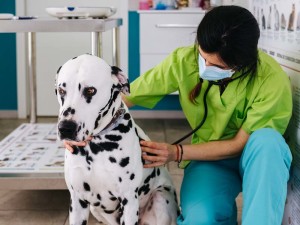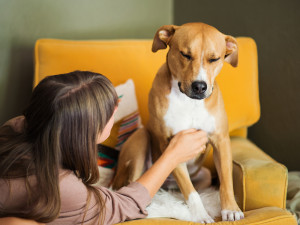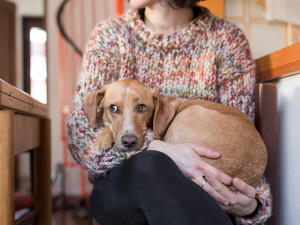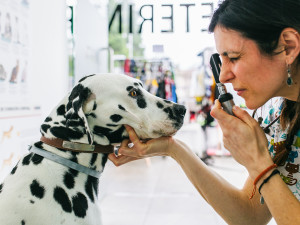Warning Signs Your Dog Needs to Go to the Hospital – Right Away
Trust me, I’m a vet

Share Article
Emergencies happen, and recognising the warning signs can save your dog’s life. But it’s not that simple, is it? Dogs throw up, twist ankles and suffer scratches just like we do and often it’s no big deal. Real emergencies have a curious way of happening at the most inconvenient times – like in the middle of the night when your vet is closed. Not only should you know where your local 24/7 emergency vet is located, but you should also know what really warrants a pet emergency. Here, seven scenarios that mean you should head straight to the animal hospital.
Your dog won’t stop throwing up
First, we’re talking about productive vomiting, when your dog actually throws up. We’ll tackle non-productive vomiting – when they’re dry heaving – below. Vomiting can mean that there’s an obstruction in your pet’s gastrointestinal tract, they’ve eaten something toxic or they’re experiencing a chemical imbalance. The cause needs to be zeroed-in on quickly and your dog needs to get to a hospital to make sure they don’t lose too much fluid and become dehydrated. The occasional one-off throw-up is nothing to worry about, but don’t hesitate to bring your dog in if the episode lasts for more than a few hours or if they get sick more than three times in a 12-hour period.
Your dog won't stop trying to throw up and/or looks bloated
We’ve all had burrito babies but bloating in dogs is not your average Friday night – it can actually be fatal. Gastric dilatation-volvulus, also known as ‘bloat’, is a condition that causes air to expand inside a dog’s stomach and make it twist, which leads to them losing blood flow to their vital organs. Your dog’s stomach may balloon up and/or they may try desperately to throw up but can’t (subtler signs are drooling and restlessly pacing around). If your dog is showing any of these symptoms, there is no time to waste: get your dog to the hospital as fast as you can. Bloat is fatal in 30% of dogs simply because it happens so suddenly. Other causes of bloating in dogs can be caused by internal bleeding, fluid accumulation tied to heart disease, or leaking intestines – no less alarming.
Your dog is stumbling or seems disoriented
If your dog suddenly appears, er, drunk, they may have snacked on something that’s toxic to them. In other cases, stumbling around and being uncoordinated can point to head trauma, severe metabolic imbalances, internal bleeding or loss of blood to the brain. If you notice your pup acting strange, skip the TikTok video and rush to the vet because intervening quickly is their best shot at a speedy recovery.
Your dog has a deep flesh wound
It can be tricky determining the severity of flesh wounds because while some look superficial, the damage they’re doing might be more than skin-deep. If you spot a small scratch on your dog that’s clearly on the surface, you can clean it with mild soap and water (or a saline solution if you have it on hand), then just keep an eye on it as it heals. But if appears deep, there’s green or yellow discharge or it isn’t improving, it’s worth having a vet look at it. If the wound is bleeding a lot, make a tourniquet from a T-shirt and head to the hospital. Finally, if your dog was bitten by another dog or scratched by a cat, take them to the vet even if it doesn’t look serious. Puncture wounds are breeding grounds for bacteria and no matter how well you clean it, the risk of infection is high.
Your dog was hit by a car
This goes without saying: get your dog to the hospital ASAP. Even if they miraculously get up and shake it off, internal trauma could be wreaking havoc without you knowing until it’s too late.
Something’s wrong with their eye(s)
Dogs’ eyes are pretty adept to to picking up contaminants. If you notice your dog suddenly squinting, if there’s excessive discharge, or if their eye has a blue/white tinge to it, head to the vet. Eye injuries are often emergencies and a quick diagnosis can be crucial in restoring their vision.
There’s just something off
You know your pet better than anyone so trust your gut. Acting ‘off’ could be anything from skipping meals to seeming lethargic. Call your vet or local animal hospital and describe your dog’s symptoms – they should be able to tell you if you should sit tight or schedule an appointment.
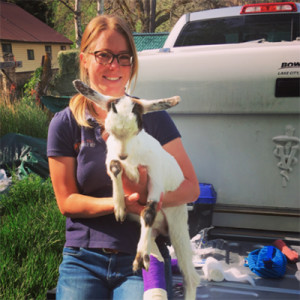
Oneal Bogan, DVM
Oneal Bogan, DVM, is a mixed animal veterinarian from Colorado. Dr. Bogan loves the variety of animals she gets to work with. She owns her own mobile practice which provides at-home care to large and small animals. Dr. Bogan also works at a local small animal clinic. In her free time, Dr. Bogan loves to hike, ride horses, and read. She also loves writing and hopes her advice helps all pets live a happy, healthy life.
Related articles
![A pet parent checks their dog's stomach.]()
DIY Physical Exam – How to Examine Your Dog’s Stomach and Skeleton
Veterinarian Dr Shea Cox on how to properly examine your dog’s stomach and musculoskeletal system
![close up of Chihuahua dog's eye with cataracts]()
Common Eye Problems in Dogs and How to Treat Them
Your dog sees you as their best friend, so keep those eyes healthy
![shy dog frightened in the arms of the owner. this brown mixed-breed hound puppy has a sweet gaze. the female owner has a wool sweater]()
Why Is My Dog Shaking? Causes and Treatment
A vet explains why the weather isn’t always to blame
![A girl stands with her small white dog among dandelions.]()
Symptoms and Treatments For Urinary Tract Infections (UTIs) in Dogs
If your pup’s bathroom habits have changed, they might have a UTI. Here’s how to help
![A dog outside with his mouth open coughing]()
Laryngitis in Dogs: Causes and Treatment
Vet advice on when you should be worried about your dog’s cough
![Young female veterinarian in her consulting room performing a medical examination on a dog for diabetes]()
Diabetes in Dogs: Symptoms, Treatment and Prevention
Learn which breeds are at risk, the symptoms to look out for and what treatment options are available.


